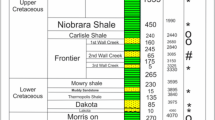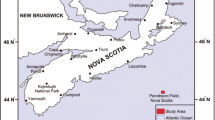Abstract
Assessing reservoir properties and knowing the relationship between different reservoir parameters can significantly help to plan for production from a reservoir. In this study, which was carried out on the gas reservoir of the Triassic Dahram Group at the South Pars Gas Field, in southern Iran, petrophysical parameters such as porosity, shale volume, saturation of water and hydrocarbon, as well as amount of different minerals in the reservoir sequence, were first calculated using the probabilistic evaluation method. In the second step, for the separation of the sequential electrofacies, the multi-resolution chart-based clustering method was used resulting in recognition of five electrofacies with different reservoir geological properties. The results obtained from the first and second steps showed that the no. 5 electrofacies (EF-5), which has clean lime lithology and has the lowest water saturation, good porosity and high gas volume, was considered as the best reservoir facies in the studied sequence. Therefore, by separation of electrofacies, a suitable relationship can be found between different geological facies and petrophysical parameters of the reservoir.









Similar content being viewed by others
References
Abdideh, M. (2012). Estimation of permeability using artificial neural networks and regression analysis in an Iran oil field. International Journal of Physical Sciences,7(34), 5308–5313.
Abdideh, M., & Moghimzadeh, M. A. (2019). Geomechanical study of gas reservoir rock using vertical seismic profile and petrophysical data (continental shelf in southern Iran). Geomechanics and Geoengineering: an International Journal,14(2), 118–135.
Abdideh, M., & Nabaei, M. (2017). A new approach for optimization productivity/injectivity in naturally fractured reservoirs based on fracture network detection using Fourier–wavelet transform approach. Journal of Petroleum Science and Technology,3(9), 922–928.
Amanipoor, H. (2013). Providing a subsurface reservoir quality maps in oil fields by geostatistical methods. Geodesy and Cartography,39(4), 145–148.
Askari, A. A., & Behrouz, T. (2011). A fully integrated method for dynamic rock type characterization development in one of Iranian off-shore oil reservoir. Journal of Chemical and Petroleum Engineering,45(2), 83–96.
Bagheri, A. M., & Biranvand, B. (2006). Characterization of reservoir rock types in a heterogeneous clastic and carbonate reservoir. Journal of Undergraduate Science and Technology,32(2), 29–38.
Cross, T. A., & Homewood, P. W. (1997). Amanz Gressly’s role in founding modern stratigraphy. Geological Society of America Bulletin, Geological Society of America.
Esfidari, E., Amini, A., Kadkhodaei, A., & Ahmadi, B. (2012). Electrofacies clustering and a hybrid intelligent based method for porosity and permeability prediction in the South Pars Gas Field, Persian Gulf. Geopersia,2(2), 11–23.
Fertl, W. H. (1981). Open hole cross-plots concepts—A power-ful technique in well log analysis. Journal of Petroleum Technology,30(2), 535–549.
Flugel, E. (2004). Microfacies of carbonate rocks. Analysis, interpretation and application. New York: Springer.
Karimian-Torghabeh, A., Rezaee, R., & Mousavi-Harami, R. (2015). Using electrofacies cluster analysis to evaluate shale-gas potential: Carynginia Formation, Perth Basin, Western Australia. International Journal Oil, Gas and Coal Technology,10(3), 324–340.
Khoshbakht, F., & Mohammadnia, M. (2012). Assessment of clustering methods for predicting permeability in a heterogeneous carbonate reservoir. Journal of Petroleum Science and Technology,2(2), 50–57.
Kumar, B., & Kishore, M. (2006). Electrofacies classification—A critical approach. In 6th international conference and exposition on petroleum geophysics. New Delhi.
Lennon, J. T. (1976). Essential of modern open hole log interpretation. Tulsa: Penn Well Publishing Company.
Lucia, F. J. (1999). Carbonate reservoir characterization. New York: Springer.
Mayer, C., & Sibbit, A. (1980). Global, a new approach to computer-processed log interpretation. Paper SPE 9341 presented at the SPE annual technical conference and exhibition. Dallas.
Nooruddin, H., & Hossain, M. E. (2012). Modified Kozeny–Carmen correlation for enhanced hydraulic flow unit characterization. Journal of Petroleum Science and Engineering,80(2), 107–115.
Peters, E. J. (2012). Advanced petrophysics. New York: Live Oak Book Company.
Pirson, P. (1977). A new tool for electro-facies analysis: Multi-resolution graph-based clustering. SPWLA, 32(4), 80–95.
Selley, R. C. (1996). Ancient sedimentary environments and their sub-surface diagnosis (4th ed.). London: Nelson Thornes.
Serra, O. (1979). Fundamentals of well-log, the interpretation of logging data. Amsterdam: Elsevier Science Publishers.
Serra, O., & Abbott, H. T. (1980). The contribution of logging data to sedimentology and stratigraphic. SPE 9270, 55th annual fall technical conference and exhibition. Dallas, TX.
Sutadiwirya, Y. (2008). Using MRGC (multi resolution graph-based clustering) method to integrate log data analysis and core facies to define electrofacies, in the Benua Field, Central Sumatera Basin, Indonesia. In International gas union research conference, IGRC. Paris.
Tvakoli, V., & Amini, A. (2006). Application of multivariate cluster analysis in log facies determination and reservoir zonation, case study of Marun Field, South of Iran. Journal of Undergraduate Science and Technology,32(2), 173–180.
Worthington, P. F. (2011). The petrophysics of problematic reservoirs. Society of Petroleum Engineers,63(12), 88–97.
Xu, C., & Torres-Verdin, C. (2012). Saturation-height and invasion consistent hydraulic rock typing using multi-well conventional logs. In SPWLA 53rd annual logging symposium.
Acknowledgments
The authors thank Islamic Azad University for their help and financial support for any data and software.
Author information
Authors and Affiliations
Corresponding author
Rights and permissions
About this article
Cite this article
Abdideh, M., Ameri, A. Cluster Analysis of Petrophysical and Geological Parameters for Separating the Electrofacies of a Gas Carbonate Reservoir Sequence. Nat Resour Res 29, 1843–1856 (2020). https://doi.org/10.1007/s11053-019-09533-1
Received:
Accepted:
Published:
Issue Date:
DOI: https://doi.org/10.1007/s11053-019-09533-1




